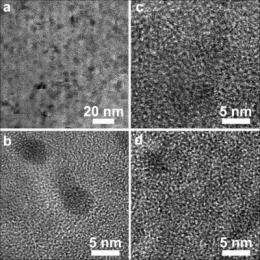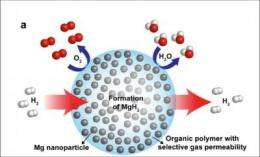Scientists achieve breakthrough in nanocomposite for high-capacity hydrogen storage

Since the 1970s, hydrogen has been touted as a promising alternative to fossil fuels due to its clean combustion —unlike hydrocarbon-based fuels, which spew greenhouse gases and harmful pollutants, hydrogen's only combustion by-product is water. Compared to gasoline, hydrogen is lightweight, can provide a higher energy density and is readily available. But there's a reason we're not already living in a hydrogen economy: to replace gasoline as a fuel, hydrogen must be safely and densely stored, yet easily accessed. Limited by materials unable to leap these conflicting hurdles, hydrogen storage technology has lagged behind other clean energy candidates.
In recent years, researchers have attempted to tackle both issues by locking hydrogen into solids, packing larger quantities into smaller volumes with low reactivity—a necessity in keeping this volatile gas stable. However, most of these solids can only absorb a small amount of hydrogen and require extreme heating or cooling to boost their overall energy efficiency.
Now, scientists with the U.S. Department of Energy (DOE) Lawrence Berkeley National Laboratory (Berkeley Lab) have designed a new composite material for hydrogen storage consisting of nanoparticles of magnesium metal sprinkled through a matrix of polymethyl methacrylate, a polymer related to Plexiglas. This pliable nanocomposite rapidly absorbs and releases hydrogen at modest temperatures without oxidizing the metal after cycling—a major breakthrough in materials design for hydrogen storage, batteries and fuel cells.
"This work showcases our ability to design composite nanoscale materials that overcome fundamental thermodynamic and kinetic barriers to realize a materials combination that has been very elusive historically," says Jeff Urban, Deputy Director of the Inorganic Nanostructures Facility at the Molecular Foundry, a DOE Office of Science nanoscience center and national user facility located at Berkeley Lab. "Moreover, we are able to productively leverage the unique properties of both the polymer and nanoparticle in this new composite material, which may have broad applicability to related problems in other areas of energy research."
Urban, along with coauthors Ki-Joon Jeon and Christian Kisielowski used the TEAM 0.5 microscope at the National Center for Electron Microscopy (NCEM), another DOE Office of Science national user facility housed at Berkeley Lab, to observe individual magnesium nanocrystals dispersed throughout the polymer. With the high-resolution imaging capabilities of TEAM 0.5, the world's most powerful electron microscope, the researchers were also able to track defects—atomic vacancies in an otherwise-ordered crystalline framework—providing unprecedented insight into the behavior of hydrogen within this new class of storage materials.

"Discovering new materials that could help us find a more sustainable energy solution is at the core of the Department of Energy's mission. Our lab provides outstanding experiments to support this mission with great success," says Kisielowski. "We confirmed the presence of hydrogen in this material through time-dependent spectroscopic investigations with the TEAM 0.5 microscope. This investigation suggests that even direct imaging of hydrogen columns in such materials can be attempted using the TEAM microscope."
"The unique nature of Berkeley Lab encourages cross-division collaborations without any limitations," said Jeon, now at the Ulsan National Institute of Science and Technology, whose postdoctoral work with Urban led to this publication.
To investigate the uptake and release of hydrogen in their nanocomposite material, the team turned to Berkeley Lab's Energy and Environmental Technologies Division (EETD), whose research is aimed at developing more environmentally friendly technologies for generating and storing energy, including hydrogen storage.
"Here at EETD, we have been working closely with industry to maintain a hydrogen storage facility as well as develop hydrogen storage property testing protocols," says Samuel Mao, director of the Clean Energy Laboratory at Berkeley Lab and an adjunct engineering faculty member at the University of California (UC), Berkeley. "We very much enjoy this collaboration with Jeff and his team in the Materials Sciences Division, where they developed and synthesized this new material, and were then able to use our facility for their hydrogen storage research."
Adds Urban, "This ambitious science is uniquely well-positioned to be pursued within the strong collaborative ethos here at Berkeley Lab. The successes we achieve depend critically upon close ties between cutting-edge microscopy at NCEM, tools and expertise from EETD, and the characterization and materials know-how from MSD."
More information: This research is reported in a paper titled, "Air-stable magnesium nanocomposites provide rapid and high-capacity hydrogen storage without heavy metal catalysts," appearing in the journal Nature Materials and available in Nature Materials online.
Provided by Lawrence Berkeley National Laboratory

















